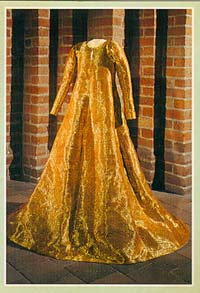 The Golden Gown of Queen Margaret
The Golden Gown of Queen Margaret The Golden Gown of Queen Margaret
The Golden Gown of Queen MargaretCommentary by Bjarne: This dress has been reconstructed by some Danes. Originally this dress was made for Margrethe I of Denmark who united Scandinavia. The fabric was remade also, of real gold metal and silk. It was on exhibit at the Danish National Museum when they had a show of Margrethe I. The gold cloth was fabulously made with a intricate wowen pattern. The reconstructed dress has long sleeves, I believe they found out that the original had long sleeves.
Fabric, from the Geijer book (see biblio info on Extant page) submitted
by Maggie Forest: The fabric is a gold brocade on a red silk ground fabric.
The design is a framework of laurel garlands with a group of five pomegranates
at
their points, surrounding a central motif of something that resembles
a pineapple. It is generally considered to be of Italian manufacture. The
gown will have used around 10 3/4 metres of fabric at the known loom width
of 60cm.
Pictures!
| Pictures taken by and copyright © Lynn
Meyer
(SCA: Halima de la Lucha) |
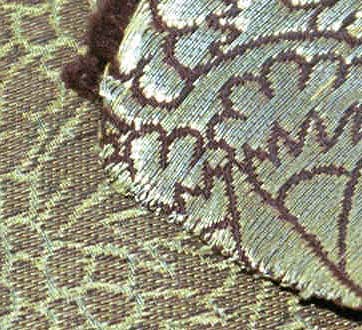 Front and back of fabric.
Front and back of fabric.
Larger view of this picture |
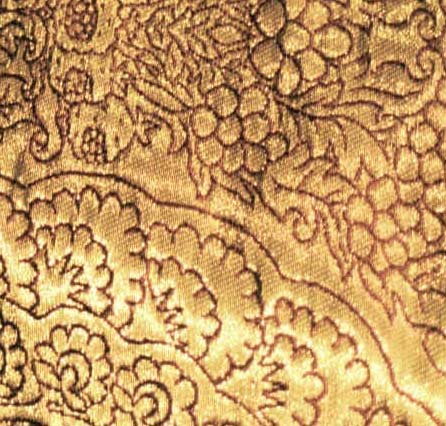 Front of fabric
Front of fabric |
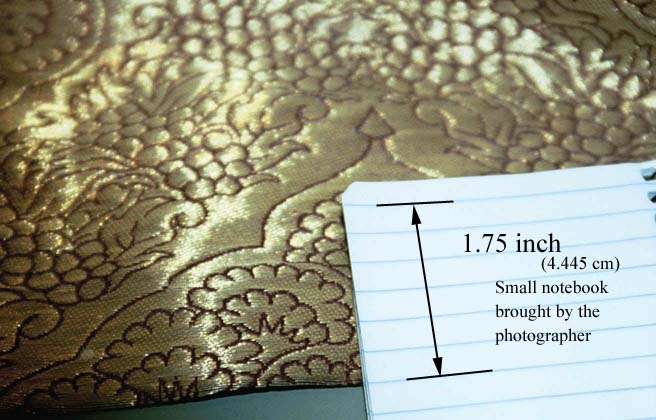 Demonstrating the scale of the fabric
Demonstrating the scale of the fabric |
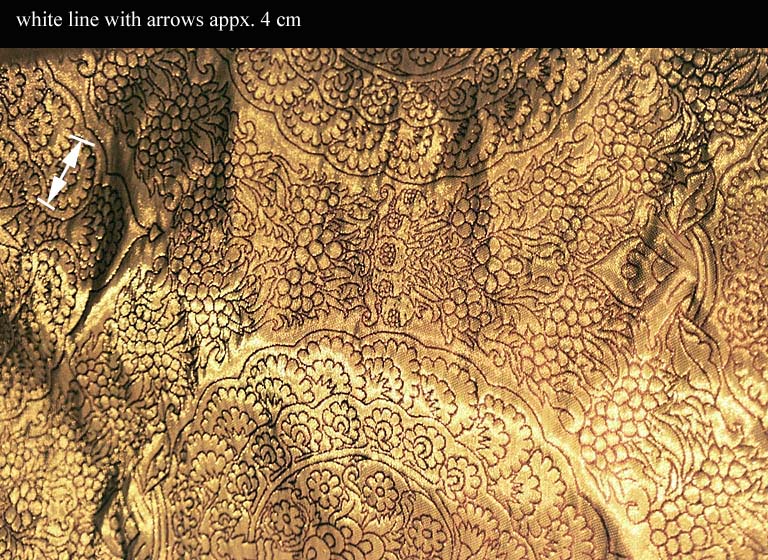 Larger view of the fabric with white line scale attempt
by cv. This makes each round medallion -- see half of one at the
bottom of the picture, about 32cm in diameter or just over a foot across.
Larger view of the fabric with white line scale attempt
by cv. This makes each round medallion -- see half of one at the
bottom of the picture, about 32cm in diameter or just over a foot across. |
Lynn Meyer writes:
I just remembered, I typed in some salient paragraphs from the book.
They may or may not be of interest to you. If so, they would of course
be attributes to Geijer, Franzen & Nockert...
The Golden Gown of Queen Margareta in Uppsala Cathedral
Drottning Margaretas gyllene kjortel i Uppsala domkyrka
Agnes Geijer, Anne Marie Franze'n, Margareta Nockert
Kungl. Vitterhets Historie och Antikvitets Akademien, Stockholm 1994
ISBN 91-7402-249-0
front page:(most of Intro from pp. 123-124, and this:)
'The first edition of this book
appeared in 1985.The second revised edition includes a radiocarbon
dating of the gown showing that it dates from the first four decades
of
the 15th century.That means that the gown could have belonged to Queen
Margareta, but it was not her wedding gown.'
pp. 121 English summary
pp. 121-123 Preface, by Nockert
'The publication in 1985 ...
three people... sharing a conviction that the gown in Uppsala was
closely connected with Queen Margareta and her age.How closely and
in
what way we were unable to establish.
'The size of the gown suggested that it could have been worn by a child
or rather a young girl.The cut is if anything 14th century, but with
a
neck design that is more typical of the 13th.The most puzzling thing
of all was the pattern of the fabric: was it really 14th century?
'Of course, we should have settled for a much vaguer dating than we
did
then, but the size and cut of the gown coupled with the traditions
surrounding it... made it tempting to suggest that this <I>might</I>
have
been Margareta's wedding gown...
'This second edition of the book incorporates a number of revisions.
... sections on costume history have also been reworked... additions
have been made to "Scandinavian Costume".
'The biggest alterations, of course have been made to Chapter II, "The
Gold Fabric of Queen Margareta's Gown", and the concluding chapter,
"Who
Can Have Worn the Golden Gown?"
'...it is in fact original seams we are dealing with here. ... With
the exception of the pieces missing as per fig. 3, the gown is a
complete medieval garment with the original cut and original seams.The
points of uncertainty concern its length at the back, where large pieces
are missing, and the appearance of the ends of the sleeves. ...'
'The narrow loom width, about 60 cm, is no evidence for a late dating.
... The choice of width depended on the type of fabric to be woven...
Five-threaded satin, which occurs in the Margareta gown, is the great
innovation of the 14th century -- mentioned, for example, in Lucca
in
1376 -- although it does not become common (dominant) until the 15th
century.
'...one welcomes the existence today of... radiocarbon dating...
specimens have now been taken from the silk included in the Margareta
fabric, and also, for comparison, from the fragmentary linen lining.
'Results showed that the Golden Gown was made in the first four decades
of the 15th century (1403-1439).
[LM: front page said Margareta ?lived? ?ruled? 1353-1412]
'The dating of this garment must hinge on the fabric.In other words,
the gown can have been made during Queen Margareta's later years or
not too long after her death.Its connection with her time is so clear
that we have no reason for speaking in terms of anything but the Golden
Gown of Queen Margareta, whether she actually wore it or not -- as
indeed was already remarked in the previous edition.'
pp. 123-4 Introduction (Geijer)
'Margareta Valdemarsdotter (1353-1412), Queen of Denmark, Norway and
Sweden, was buried in Roskilde Cathedral.The memory of this powerful
and revered sovereign is perpetuated there by the tomb-chest bearing
her carved portrait.The golden gown which she according to one tradition
wore at her wedding used also to be displayed there.When Denmark
was ravaged by the Swedes in 1658, this costly relic was removed and,
by order of King Charles X, deposited in Uppsala Cathedral.
'The golden gown was rediscovered by Agnes Branting who in 1911
published an account of it in German, which made it internationally
known as the only medieval gala dress still extant in Europe.It had
long been obvious that Agnes Branting's description was in need of
revision and also that an accurate restoration of the gown was required.
The highly diversified task was entrusted to the undersigned together
with Anne Marie Franze'n, who was expeccted to be responsible for most
of the project.The undertaking began in 1959 at the Textile Department
of the Central Board of National Antiquities.However, heavy official
duties and prolonged illness prevented A.M. Franze'n from completing
her
manuscript according to plan, and finally her work was cut short by
her
untimely death in 1975.It was not until Margareta Nockert joined the
task that we were able between us to complete this publication.'
pp. 124-5 Chapter I. Condition and practical measures
1907/1908 and 1959/1960
pp. 125- The gold fabric of queen Margareta's gown
'The design consists of two main components: a framework of vertical
waves, dividing the surface into ogival fields, and an identical,
symmetrical composition within each field.The pattern repeat is 30
(=15 + 15) cm wide and 49-50 cm high.The centre motif resembles a
pineapple,
while the framework consists of laurel garlands with a group of five
real pomegranates at their tangential points (Fig. 12-13).Finally
there is on more, almost invisible detail: a contour line encircling
the
whole of the centre motif and at the top forming a kind of "accolade".
(Note that the same feature reappears in the great round leaves typical
of the Quattrocento velvets, incorrectly termed "pomegranate pattern".)
The real pomegranate tree, Punica granatum, is a native of both Asia
and
Africa, where its fruit, with its many seeds and delicious flavour,
ranked as a fertility symbol and had therefore been assiduously depicted
for thousands of years.Oddly enough, however, the name of this fruit,
Granatapfel (=pomegranate), was applied, probably in the late 19th
century,
to the ancient floral motif (originally derived from the sacred lotus)
which frequently reappeared in Italian silk weaving of the Quattrocento.
'Technically speaking the weave is a diasper (or lampas).This
comprises two separate layers in weft-faced and warp-faced binding
respectively, forming a pattern by alternating on the surface; the
main
technique used in 14th century Italian silk weaving, but also occurring
before and after that period.The ground weave of the gold fabric is
a
five-shaft warp satin with a thread count of 80 per cm. [LM: 200/in!]
The pattern-forming layer of the weave is shot through with gold.
The gold thread is a lamella spun round a silk thread.Due to the
thinness
and unevenness of the gilt layer, the silver sometimes shows through.
The silver itself contains copper (9%) and lead (0.3%) additives, while
the gilt is 75% gold, 21% silver and 4% copper.The gold weft is tied
with a thin warp of yellow silk, S-spun and with a thread count of
22
per cm. [LM: 55/in]The fabric has distincly marked selvages of bright
green silk, but most of the selvage has been cut away.Between the red
and the green warp threads there is one stout linen thread around which
the goldthreads [sic] sometimes turn.The loom width inside the green
selvage measures 60 cm.
pp. 125-6 Method of attribution
'The technique and quality of the gold fabric, as well as the general
character of the pattern, leave no room for doubting that the country
of
origin is north Italy...
'In the case of Italian silk manufacturing, with its very large scale
and also remote export trade -- extending as far as the Nordic countries
-- one not infrequently finds evidence of a certain pattern having
remained a standard commodity for well over a hundred years.
'With luck, contemporary pictorial art can be a useful aid to the dating
of textiles, but the reliability with which a textile pattern is
depicted depends entirely on the artist's technique.Depictions of this
kind in Italian painting of the Quattrocento form the subject of an
outstanding scientific study by Brigitte Klesse, but unfortunately,
little help is to be had from that quarter, due above all to the more
or
less cursory technique of painting which prevailed in Italy at that
time.On the other hand, the meticulous illusory painting of the 15th
century can very often be helpful in the identification of various
textile phenomena, and especially the standard velvet brocades, in
gold
and full colours, depicted with such bravura by the Netherlands and
north German painters of the 15th century.
pp. 126-7 Italian silk weaving
'Falke was the first to show that the surviving silk fabrics must have
been produced in the north Italian cities which enjoyed such fame in
this field.
'...an American economic historian, Florence Edler de Roover, who still
more emphasised the leading position of Lucca.
'In 1153 Lucca concluded a treaty with Genoa which came to have
important consequences.
[More later -- Ed.]
| © 2000 Cynthia Virtue except as noted | Email Author with comments |
| Back to Extant Garment Page | Back to Article Index |